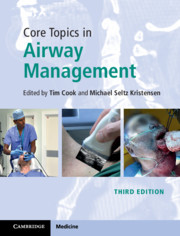Book contents
- Core Topics in Airway Management
- Core Topics in Airway Management
- Copyright page
- Contents
- Contributors
- Foreword
- Preface to the Third Edition
- Section 1 Airway Management: Background and Techniques
- Chapter 1 Anatomy
- Chapter 2 Physiology of Apnoea, Hypoxia and Airway Reflexes
- Chapter 3 The Epidemiology of Airway Management Complications
- Chapter 4 Structured Planning of Airway Management
- Chapter 5 Pre-anaesthetic Airway Assessment
- Chapter 6 Pre-anaesthetic Airway Endoscopy, Real and Virtual
- Chapter 7 Ultrasonography for Airway Management
- Chapter 8 Oxygenation: before, during and after Airway Management
- Chapter 9 Awake Tracheal Intubation
- Chapter 10 Drugs for Airway Management
- Chapter 11 How to Avoid Morbidity from Aspiration of Gastric Content to the Lungs
- Chapter 12 Face Mask Ventilation
- Chapter 13 Supraglottic Airways
- Chapter 14 Tracheal Intubation: Direct Laryngoscopy
- Chapter 15 Tracheal Tube Introducers (Bougies), Stylets and Airway Exchange Catheters
- Chapter 16 Tracheal Intubation Using the Flexible Optical Bronchoscope
- Chapter 17 Videolaryngoscopy
- Chapter 18 Expiratory Ventilation Assistance and Ventilation through Narrow Tubes
- Chapter 19 Multimodal Techniques for Airway Management
- Chapter 20 Front of Neck Airway (FONA)
- Chapter 21 Extubation
- Section 2 Airway Management: Clinical Settings and Subspecialties
- Section 3 Airway Management: Organisation
- Index
- References
Chapter 18 - Expiratory Ventilation Assistance and Ventilation through Narrow Tubes
from Section 1 - Airway Management: Background and Techniques
Published online by Cambridge University Press: 03 October 2020
- Core Topics in Airway Management
- Core Topics in Airway Management
- Copyright page
- Contents
- Contributors
- Foreword
- Preface to the Third Edition
- Section 1 Airway Management: Background and Techniques
- Chapter 1 Anatomy
- Chapter 2 Physiology of Apnoea, Hypoxia and Airway Reflexes
- Chapter 3 The Epidemiology of Airway Management Complications
- Chapter 4 Structured Planning of Airway Management
- Chapter 5 Pre-anaesthetic Airway Assessment
- Chapter 6 Pre-anaesthetic Airway Endoscopy, Real and Virtual
- Chapter 7 Ultrasonography for Airway Management
- Chapter 8 Oxygenation: before, during and after Airway Management
- Chapter 9 Awake Tracheal Intubation
- Chapter 10 Drugs for Airway Management
- Chapter 11 How to Avoid Morbidity from Aspiration of Gastric Content to the Lungs
- Chapter 12 Face Mask Ventilation
- Chapter 13 Supraglottic Airways
- Chapter 14 Tracheal Intubation: Direct Laryngoscopy
- Chapter 15 Tracheal Tube Introducers (Bougies), Stylets and Airway Exchange Catheters
- Chapter 16 Tracheal Intubation Using the Flexible Optical Bronchoscope
- Chapter 17 Videolaryngoscopy
- Chapter 18 Expiratory Ventilation Assistance and Ventilation through Narrow Tubes
- Chapter 19 Multimodal Techniques for Airway Management
- Chapter 20 Front of Neck Airway (FONA)
- Chapter 21 Extubation
- Section 2 Airway Management: Clinical Settings and Subspecialties
- Section 3 Airway Management: Organisation
- Index
- References
Summary
A major challenge of airway management is safe care of the patient with a narrowed airway. Small tracheal tubes offer one solution but pose a problem with ventilation. While inspiration may be achieved by use of a high-pressure source to overcome airway resistance, two problems exist: first, the high-pressure source demands technical excellence and exposes the patient to a high risk of barotrauma; second, conventional (passive) exhalation through a narrow tube is slow and cannot achieve a normal minute ventilation with a tracheal tube of less than 4.5 mm diameter. Recently technical developments have led to the ability to assist expiration and make it, like inspiration, an active process. This technology is used in the Ventrain manual ventilator, the 2.4 mm wide Tritube tracheal tube and the Evone automatic ventilator. These new devices and the applied technology enable solutions for safe management of the narrowed upper airway.
- Type
- Chapter
- Information
- Core Topics in Airway Management , pp. 161 - 165Publisher: Cambridge University PressPrint publication year: 2020



